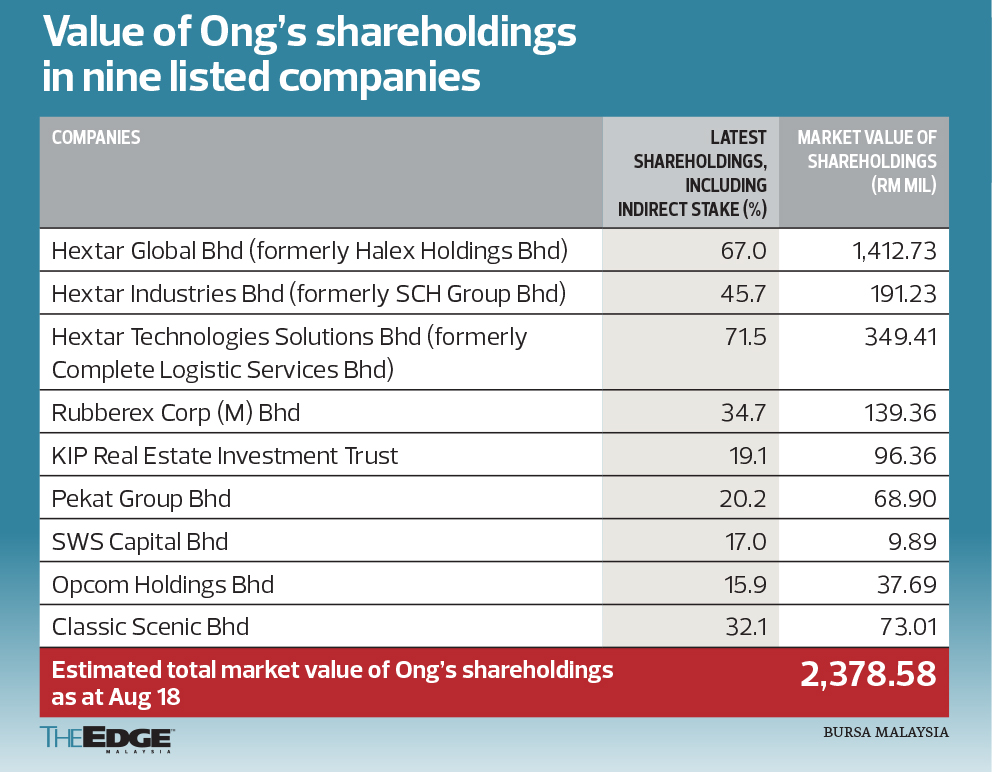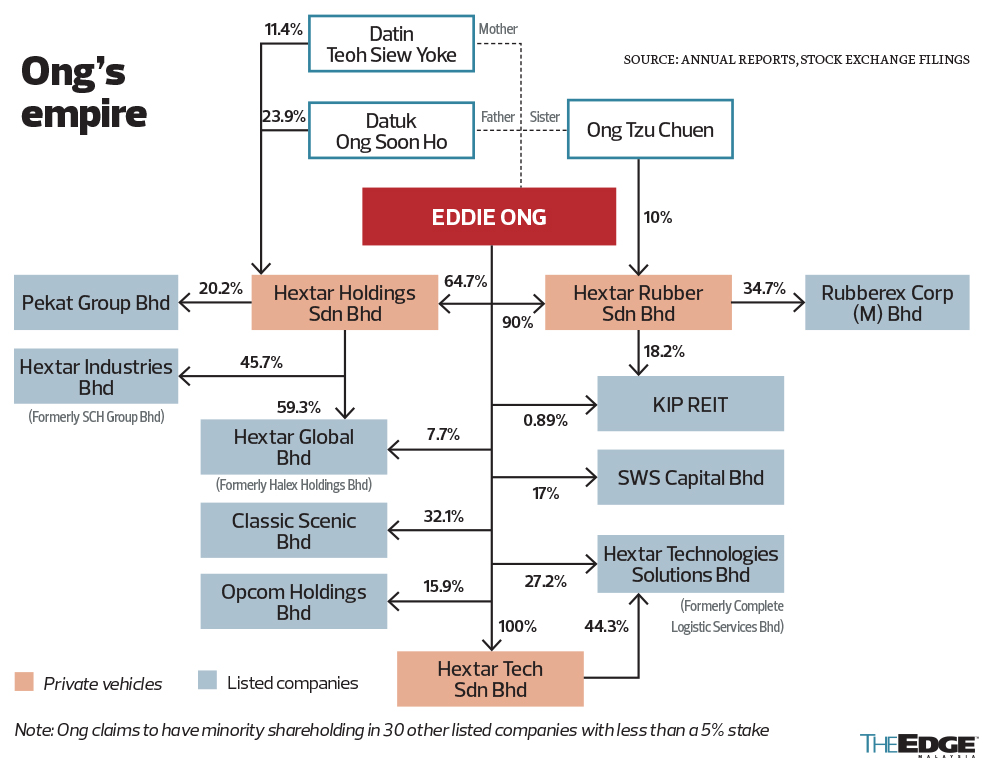
"We have about 30 stocks in our investment portfolio, with ownership ranging from 2% to 4.9%.” — Ong
This article first appeared in The Edge Malaysia Weekly on August 22, 2022 - August 28, 2022
HEXTAR Group CEO Datuk Eddie Ong Choo Meng is probably one of the most talked about corporate personalities in the investing fraternity. Over the past few years, the 44-year-old businessman and his family vehicle, Hextar Holdings Sdn Bhd, have been actively buying into companies.
Today, Ong and his family control nine public-listed companies (PLCs) on Bursa Malaysia. They also have minority stakes in another 30 PLCs.
Ong has been involved in corporate actions ranging from mergers and acquisitions (M&A) to asset injections, asset sales, business diversification and takeover offers — all within a span of five years, if not shorter.
Some retail investors have been tracking his acquisition trail as they somehow believe he can provide the catalyst for a share price rally. However, conservative investors see him in a different light, to say the least.
So, just who is Ong?
In 1985, his father Datuk Ong Soon Ho started agrochemicals marketing firm Hextar Chemicals Sdn Bhd in Klang, Selangor. This gave him a base to grow the Hextar Group of Companies into the country’s largest pesticide producer. The group manufactures chemical fertilisers and industrial chemical products, among others.
Ong entered the Malaysian corporate scene by engineering a reverse takeover of Hextar’s rival Halex Holdings Bhd in 2017. Subsequently, Hextar’s agrochemical arm, Hextar Chemicals Ltd, was injected into Halex for RM596.79 million. The latter was then renamed Hextar Global Bhd.
But it was Rubberex Corp (M) Bhd where Ong made a massive killing as the share price skyrocketed from a low of 24 sen to a peak of RM2.95 (after price adjustment following bonus issue of shares).
The investment allowed him to ride the unprecedented glove mania during the Covid-19 pandemic in 2020. He made his name with that move.
However, Ong attributes the lucrative investment to luck. “Whether Rubberex was the Midas touch, if you ask me, the answer may be no. I was very lucky,” he says in an interview.
Notably, Ong bought a 27% stake in the Ipoh-based glove maker in late February 2020, a few months before the start of the global Covid-19 pandemic. Logically, the return on investment would have boosted his war chest, allowing him to be aggressive and bold in his ventures.
Ong also has under his belt companies such as Hextar Industries Bhd (formerly known as SCH Group Bhd), Hextar Technologies Solutions Bhd (formerly known as Complete Logistic Services Bhd), Classic Scenic Bhd, KIP Real Estate Investment Trust (REIT), Pekat Group Bhd, SWS Capital Bhd and Opcom Holdings Bhd. Recently, a series of corporate exercises involving Hextar Industries, Hextar Tech, Classic Scenic and KIP REIT cast the spotlight on him again.
What exactly does Ong want to accomplish?
Critics are likely to say that he is just another rogue investor who wants to make a quick profit on the stock market, that he is not serious about running the businesses.
“There have been a lot of questions raised. Who is this guy, Eddie Ong? Why does this young businessman keep buying into so many companies? Is he taking money out of the PLCs? The answer is NO. We reserve the money to grow the business, and that is our whole intention,” he clarifies.
Ong tells The Edge that he has been rejecting media interviews as it is not his intention to gain fame. “Our intention is to grow our businesses and, of course, that would attract some attention, whether you like it or not,” he says, adding that hundreds of deals come to him every year, many of which have been rejected.
“When we came into the market a few years ago, we kept buying into listed companies, so a lot of people categorised me as a person who manipulates or does some hanky-panky in the PLCs. It is very hard for me to go out there and respond. We would rather build our businesses, and I believe the result will speak for itself.”
Interestingly, Ong sees himself as a dealmaker rather than an entrepreneur. Nevertheless, he stresses that he will create shareholder value in the companies that he has invested in.
Ong highlights that the currently weak market sentiment does not prevent him from sniffing out opportunities and grabbing every chance to expand his business empire.
“Hextar is still a small group, but we are growing at a very fast pace. Our vision is to grow Hextar [Group] into a conglomerate with diversified interests. We are definitely in it for the long haul as we intend to create about eight to 10 times market value from where we are today in 10 years’ time.”
Ong currently sits on the board of Hextar Global as executive director. He is also non-executive director at Rubberex and Hextar Industries, into which he is injecting his family’s fertiliser business for RM480 million (see “Second asset injection by Ong within two months” on Page 27).
“In terms of compound growth, we are looking at about 30% a year. We are a fast growing company, we have big ambitions, and we believe we can achieve that by not only organic growth, but also M&A,” he elaborates.
Ong holds a Bachelor of Business (Economics and Finance) from the Royal Melbourne Institute of Technology in Australia. He has been in the agriculture industry for more than 18 years, but he has specialised in finance and investments rather than fertiliser formulations.
Ong has a different business philosophy compared with his father, Soon Ho’s. “My dad doesn’t do M&A, he doesn’t like borrowing, the bank is never his buddy. We do entirely different things, I love M&A. From the day we go in, we know that M&A is only our way. So, the good thing is that a lot of M&A we [undertook] were very successful, and that gives us more bullets to go forward,” he says.
Nine PLCs being managed individually
Ong realises that he is said to control more than 20 to 30 companies. The dealmaker, however, wants to put it on record that he only controls nine PLCs, which are either directly under his name or companies that are majority-owned by him (see shareholding chart).
“The good thing about us is that all these businesses are being managed differently. We are very different from other [diversified] groups, we do not have any inter-shareholding structure between these nine companies,” he says, highlighting that there is unlikely to be systemic risk if one company in his portfolio fails.
Ong stresses that all nine PLCs have different offices, management teams, warehouses and factories. “We don’t even put the same people on the boards. They are all clearly professionally run based on industry standards. We will be expanding our businesses, but they will not be mixed together,” he says.
“Once all the businesses are mature, we will have a mix of old industries together with new-economy sectors that are booming. We intend to create a big and complete ecosystem for our group, enabling us to be a bigger player in Malaysia.”
At a time when global equity markets are tumbling as economic fears grow, Ong insists that he does not consider it a bad market from his point of view. “Of our nine PLCs, I think six of them had their best quarter in the entire history of the listed company. So, when people say the market is bad, I don’t think we are affected,” he says.
“Hopefully, when prices come down, it will give us an opportunity to buy more shares, because we are always a long-term player in the industry. If you look at my shareholdings, I don’t think I have sold any shares apart from Rubberex.”
To recap, when Rubberex’s share price was on the climb, Chin Hin group founder Datuk Seri Chiau Beng Teik, who had subscribed to a share placement, later sold his equity interest to Ong at 38% below market price. The transaction prompted many to wonder about Chiau’s rationale for selling at such a low price when the glove mania still had momentum.
Ong was then obliged to make a mandatory general offer that was substantially below market price, and raised his stake to 50.1% from 29% in the process. Given the low offer price, there were hardly any takers.
When asked whether he and Chiau were parties acting in concert as the duo have invested in a number of similar companies, Ong refutes the claim. “Yes, we are friends. And we believe in our business models. So, I also took a stake in a lot of his companies. I don’t think these are parties acting in concert.
“We are still looking for big investments together, not only Chin Hin. We are also investing in a lot of things together with other partners. Like the [Empire City] Mall, I only invested 20%. But I have other partners, so it is not only Chin Hin. I don’t think it is right to make that accusation.”
Ong admits that apart from his aggressive buying spree, he has nothing more to shout about. He sees that his efforts to create shareholder value are still a work in progress that have yet to bear fruit.
Will Ong’s aggressive M&A spree — something that his father and many entrepreneurs would never do — help him to build a solid diversified portfolio that yields sustainable returns rather than make a quick buck from share price movements? As the saying goes, only time will tell.
Save by subscribing to us for your print and/or digital copy.
P/S: The Edge is also available on Apple's App Store and Android's Google Play.
- Sapura Energy bags multiple contracts worth nearly RM100 mil
- Anwar, Xi witness exchange of 31 MOUs and documents to advance Malaysia-China cooperation
- Bina Puri announces boardroom changes, founder director Tan Cheng Kiat retires
- King confident Malaysia, China will continue to empower cooperation
- Bank Rakyat flags challenging 2025, keeps 17% dividend for FY2024
- Putrajaya orders temporary closure of KL Tower, says past concessionaire's stay 'unlawful'
- Meta saw TikTok as ‘highly urgent’ threat, Zuckerberg says at antitrust trial
- Sapura Industrial, Gas Malaysia, CapitaLand, Hextar Technologies, Golden Land, Skyworld, Sapura Energy, Bina Puri, Paragon Globe, OCK Group, Nextgreen, Nexgram
- Ivory Properties aborts land disposal deal with Chin Hin following liquidation of subsidiary
- Tesla slumps below 50% share of California’s electric car market


